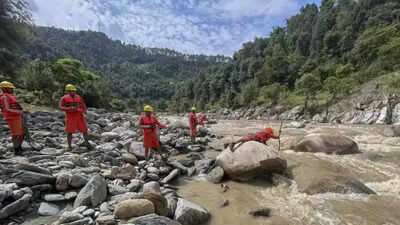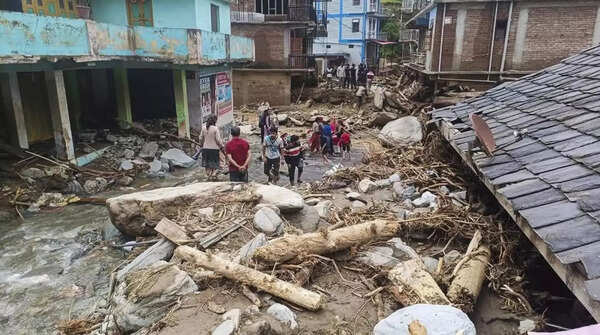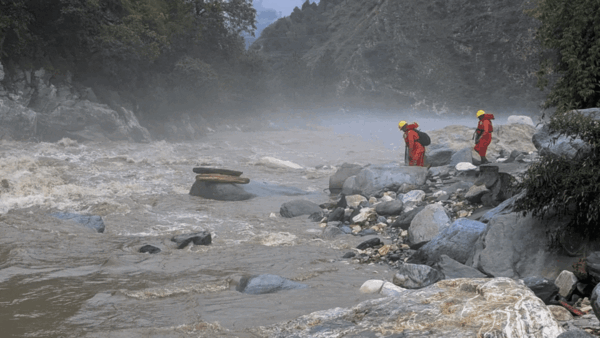Himachal Pradesh monsoon havoc: Toll rises to 74, rescue teams race against time in Mandi for 30 missing; IMD issues red alert | Shimla News

NEW DELHI: Torrential monsoon rains continue to wreak havoc across Himachal Pradesh, with the death toll climbing to 74 and over three dozen people still missing. In the worst-hit Mandi district, rescue operations intensified on Saturday as authorities scrambled to locate at least 30 individuals feared trapped under debris following flash floods and cloudbursts earlier this week. Search teams from the State Disaster Response Force (SDRF), National Disaster Response Force (NDRF), police and army have been deployed but challenging terrain and damaged infrastructure have severely hampered efforts.

“We’ve not been able to locate any of the missing persons yet,” said Mandi deputy commissioner Apoorv Devgan, noting that 31 individuals remained unaccounted for. “The relief work is difficult because of the geography. This is only the beginning of the monsoon and we must now manage relief, rehabilitation and restoration over the next three months.” A team from the Indo-Tibetan Border Police (ITBP) has also been deployed in Thunag, one of the worst-affected regions. The team is coordinating with local authorities to assist in rescue, debris removal and aid distribution.
Red alert as more rains loom
The India Meteorological Department has issued a red alert for Sunday, warning of heavy to extremely heavy rainfall accompanied by thunderstorms and lightning, particularly in Mandi, Kangra, and Sirmaur districts. Several other districts including Una, Bilaspur, Hamirpur, Shimla, and Solan have also been placed on high alert.

NDRF personnel during a rescue operation for missing persons who were feared swept away in the recent cloudburst-triggered flash floods at Sainj valley, in Kullu district, Himachal Pradesh. (PTI Photo)
Many parts of Mandi remain cut off due to road damage. On Saturday evening, 238 roads across Himachal were blocked, including 176 in Mandi alone, the State Emergency Operations Centre (SEOC) reported. Essential services also took a hit — 258 power distribution transformers and 289 water supply schemes were disrupted, most of them in Mandi.
Widespread damage, mounting losses
Between June 20 and July 5, the hill state has suffered an estimated loss of over ₹566.87 crore, with 115 people injured, according to official data. In addition to 45 monsoon-related deaths, 30 accidental fatalities were also reported, including those caused by road accidents, electrocution, and gas explosions. The SEOC confirmed that 20 deaths occurred in Mandi and 13 in Kangra, with 37 people still missing across the state. In response, the government has provided 1,317 food kits containing essential supplies to affected families, while more aid is being mobilised.
Relief and rehabilitation efforts intensify
Chief minister Sukhvinder Singh Sukhu on Saturday assured the public that the situation was “rapidly returning to normal” in disaster-hit areas of Seraj constituency. He announced a monthly rent assistance of Rs 5,000 for families whose homes were destroyed in the disaster. “The government is fully committed to tackling this crisis. All departments are on alert as we prepare for more rains,” the CM said. Meanwhile, Deputy Chief Minister Mukesh Agnihotri visited affected areas in Seraj and Nachan constituencies, met with displaced families, and directed officials to expedite road repairs and restore power and clean drinking water. He also announced that the Baglamukhi ropeway would operate free of charge until further notice to aid relief movement, benefiting 1,500 people so far. The ropeway service will be available on call during emergencies.
Emergency healthcare outreach
On Saturday, SDRF teams conducted door-to-door assessments in Jarode Panchayat, distributing medical kits and identifying individuals in urgent need of care. Officials said the findings were shared with district authorities to ensure targeted follow-up. Medical personnel provided on-site assistance and essential medicines to residents, while food and daily-need supplies were distributed across affected pockets.





